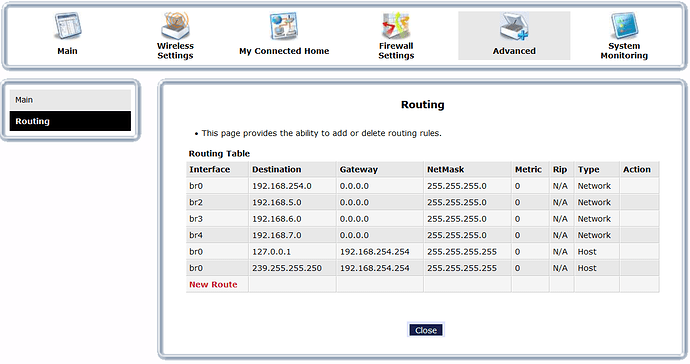This is what I got:
# tcpdump -i eth1 -vn host 192.168.254.254
tcpdump: listening on eth1, link-type EN10MB (Ethernet), capture size 262144 bytes
16:01:27.324280 IP (tos 0xb8, ttl 1, id 0, offset 0, flags [DF], proto UDP (17), length 307)
192.168.254.254.1900 > 239.255.255.250.1900: UDP, length 279
16:01:27.342848 ARP, Ethernet (len 6), IPv4 (len 4), Request who-has 192.168.254.254 tell 192.168.254.254, length 46
16:01:28.335183 IP (tos 0xb8, ttl 1, id 0, offset 0, flags [DF], proto UDP (17), length 370)
192.168.254.254.1900 > 239.255.255.250.1900: UDP, length 342
16:01:28.353702 ARP, Ethernet (len 6), IPv4 (len 4), Request who-has 192.168.254.254 tell 192.168.254.254, length 46
16:01:29.344740 IP (tos 0xb8, ttl 1, id 0, offset 0, flags [DF], proto UDP (17), length 298)
192.168.254.254.1900 > 239.255.255.250.1900: UDP, length 270
16:01:29.362370 ARP, Ethernet (len 6), IPv4 (len 4), Request who-has 192.168.254.254 tell 192.168.254.254, length 46
16:01:30.354569 IP (tos 0xb8, ttl 1, id 0, offset 0, flags [DF], proto UDP (17), length 307)
192.168.254.254.1900 > 239.255.255.250.1900: UDP, length 279
16:01:30.372190 ARP, Ethernet (len 6), IPv4 (len 4), Request who-has 192.168.254.254 tell 192.168.254.254, length 46
16:01:31.366207 IP (tos 0xb8, ttl 1, id 0, offset 0, flags [DF], proto UDP (17), length 366)
192.168.254.254.1900 > 239.255.255.250.1900: UDP, length 338
I do however get quite a bit when viewing the modem's web interface from a PC on the network. I'm attempting to set up a syslog server on openwrt if possible or my PC if that proves difficult. Then Ill send logs there for easier viewing since the modem doesn't have a decent log viewer in the web interface, and is fairly locked down as far as connecting a serial UART.




